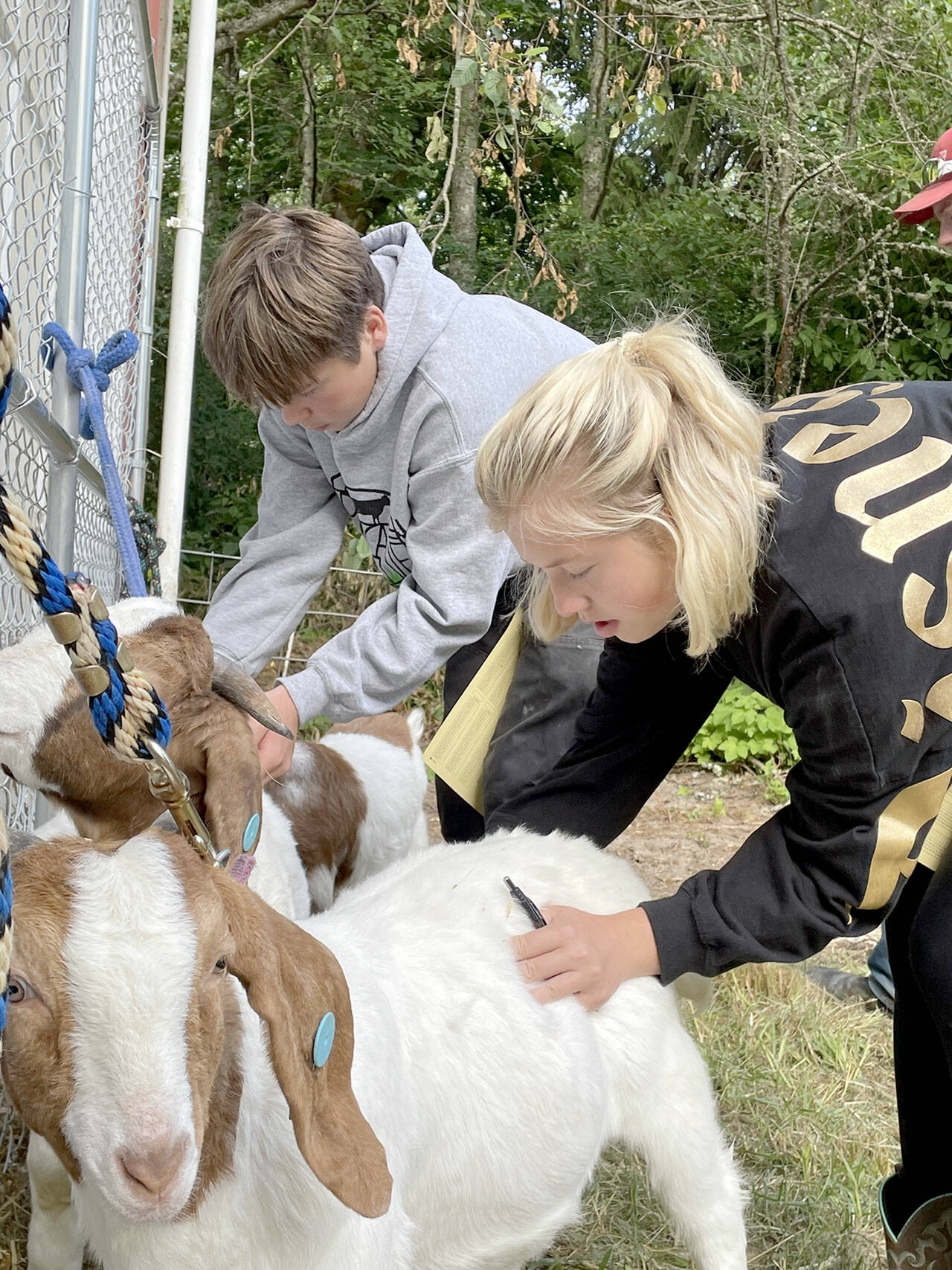SEQUIM — To the untrained eye, Forrest Gump is hardly distinguishable from his friends Clyde and June. But to members of the Clallam County 4-H livestock judging team, there are noticeable differences among the three brown and white Boer goats.
Qualities like the width, depth and length of their loins, the deepness of their chests and the thickness of their thighs and hind legs distinguish a first-place meat goat from a second-place goat, or a third-place goat from a fourth-place one.
The eight youths heading to Moses Lake today for Saturday’s Washington 4-H Livestock Judging Contest don’t just need to know how to distinguish a good meat goat from a great one, they also need to know how to evaluate goat breeding stock and their potential to produce high-quality offspring. And, they also must judge the same market and breeding qualities in beef cattle, sheep and swine.
Dan McCarty, the livestock specialist at WSU Clallam County Extension, has been coaching the team on not just how to evaluate animals but how to explain to a judge why they placed the four animals in each class the way they did.
“It gives these kids an opportunity to develop their decision-making skills, public speaking skills and gives them salesmanship experience,” McCarty said. “They’re all really good and I really have high hopes this year.”
The expectations are high because last year’s intermediate judging team of Cole Anderson, Asha Swanberg, Lukas Teague and Zoey Van Gordon “swept up,” McCarty said.
The teenagers won first place overall in team judging, first place in goat judging, second place in sheep, third place in swine and fourth place in beef.
The 4-Her’s on this year’s team had gathered last week at Candy Seelye’s property for their last practice before heading to the competition. They had already practiced judging beef cattle, sheep and swine at local farms that had volunteered their animals for the sessions.
Seelye provided the Boer meat goats and breeding does for the team to evaluate and she gave instructions on what to look for.
“Put your hands on their loin because that’s your money cut,” Seelye said.
After they had filled out their one-page judging sheets, McCarty asked them how they had placed the four goats and the reasons why.
Just as in the real competition, the 4-Her’s couldn’t check their evaluation sheets or even glance at the animals. They had to look directly at McCarty and answer his questions by memory with confidence and precision. They are judged on accuracy, completeness, use of correct grammar and knowledge of livestock terminology.
“Why did you place 2 ahead of 4?” McCarty asked 14-year-old Tim Seelye.
“It’s probably stronger on the bone,” Seelye said.
“It IS stronger on the bone,” McCarty corrected him.
Judges will even throw in a ringer question to make sure a competitor had thoroughly evaluated each animal and knew its relative strengths and weaknesses.
“They might ask, ‘Which one had the red ear tag?’” McCarty said.
In addition to the in-person practice sessions, the team has been taking four to six online livestock judging classes a week since January, although they said it was not as helpful as seeing the animals and getting direct feedback from McCarty.
Joanna Seelye, 16, said she had been judging livestock since the third grade and loves the competition.
“I feel most confident judging cattle because I’ve shown cattle and they are my passion,” Seelye said. “Goats might be my weakest.”
Like Joanna Seelye, Asha Swanberg, 14, said judging beef cattle was her strongest class because she had experience raising and showing them.
“Hogs are probably my weakest because I don’t work with pigs as much,” Swanberg said.
Having a thorough knowledge of livestock and a polished oral presentation isn’t all. To emphasize the seriousness of the competition and to strive for a professional appearance, 4-Her’s must wear appropriate attire consisting of jeans or khaki pants with a dress or polo shirt that is tucked in; no pants with holes, shirts with tears or graphic T-shirts. Ignoring the dress code or acting inappropriately could result in a disqualification.
“It’s an all-day event,” McCarty said. “Which is why we’ll cut the kids loose at a water park on Friday night, then they’ll be good to go in the morning.”
This year’s Clallam County livestock judging team is composed of Port Angeles High School students Savannah Boulton, 16; Jackson Pankey, 15; Lukas Teague, 15; and Zoey Van Gordon, 15; Tim Seelye, 14, from Sequim Middle School and his sister Joanna Seelye, 16, from Sequim High School; Asha Swanberg, 14, who is home schooled in Port Angeles; and Cole Anderson, 13, from Seaview Academy in Port Angeles.
________
Reporter Paula Hunt can be reached at paula.hunt@soundpublishing.com.

